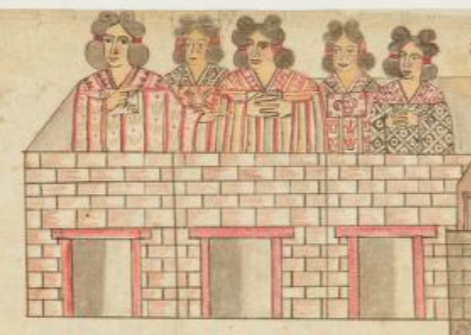cihuapilli (Azca30)
This painting is an unglossed iconographic example of a Nahua noblewoman (what we are labeling a cihuapilli). She is standing with a group of other noblewomen, and therefore her huipilli (blouse) is obscured somewhat, but one can see a four-petaled flower, something of a quincunx, on the placard or patch of fabric that appears just below the V-neck. The shape of this flower is possibly a reference to tonalli (day, sun), if we compare it to the Atonal glyph, below. This garment is red, black, and white. She also has red ties in her hair, which she wears in the neaxtlahualli style, with two protrusions above her forehead. The red tie may be a tochacatl (a red hair tie that is cord-like, or like a candle wick). See the Gran Diccionario Náhuatl.
Stephanie Wood
The huipiles in the contextualizing image are remarkable for their individual designs and patterns. The neaxtlahuall hairstyle is somewhat curvier than usual, and the red ties do not seem quite typical. See the other cihuapilli, below.
Stephanie Wood
post-1550, possibly from the early seventeenth century.
Jeff Haskett-Wood
mujeres, huipiles, textiles, cabello, pelo, quincunces, nobleza, axtlacuilli
cihuapil(li), noblewoman or lady, https://nahuatl.wired-humanities.org/content/cihuapilli
la mujer indígena noble
Stephanie Wood
The Codex Azcatitlan is also known as the Histoire mexicaine, [Manuscrit] Mexicain 59–64. It is housed in the Bibliothèque Nationale de France, and hosted on line by the World Digital Library and the Library of Congress, which is “unaware of any copyright or other restrictions in the World Digital Library Collection.”
https://www.loc.gov/resource/gdcwdl.wdl_15280/?sp=30&st=image
The Library of Congress is “unaware of any copyright or other restrictions in the World Digital Library Collection.” But please cite Bibliothèque Nationale de France and this Visual Lexicon of Aztec Hieroglyphs.



